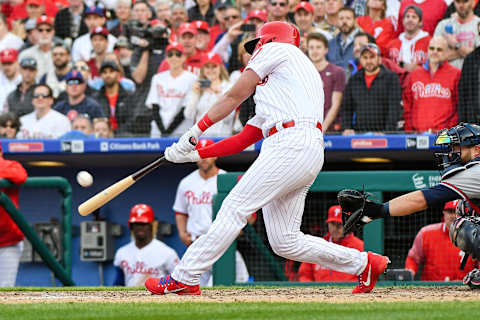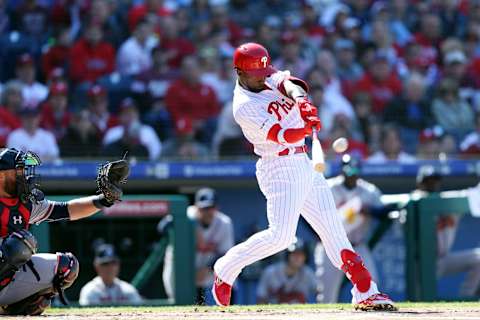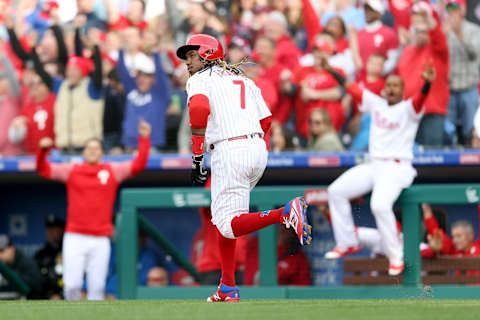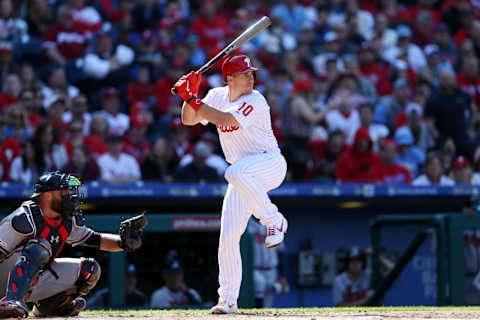Phillies: Push-button lineup’s hurdles


While the Phillies offense –for the most part– is positive, the batting order like most in the majors has drawbacks despite general manager Matt Klentak’s extremely successful offseason and $488 million in new commitments.
Goliath returns:
With a full schedule ahead, Philadelphia Phillies fans are pointing out the obvious shortcoming on the active 25, but opposing managers can exploit some offensive areas too. And even if the Fightins luck out healthwise, no team is flawless, and the long 162 will expose every blemish.
IN OTHER WORDS: “It breaks your heart. It is designed to break your heart.” – A. Bartlett Giamatti
Regarding lineups, writers and the faithful express beliefs about specific players. However, this article covers each spot with the skipper’s approach including drawbacks he’ll face with his current batting order.
Constructing a roster has limits for all clubs. And execs can’t financially plug every hole because the highest penalty is 75 percent for over $246 million AAV (average annual value): the first two tax thresholds are $206 million and $226 million. Realistically, adding $30 million AAV to $246 million AAV equals a $22.5 million tax.
As for analytics, organizations rely on them for even the slightest advantage and any offensive shortcomings. But the Phils’ trades and signings at four positions have made avoiding a set lineup difficult for manager Gabe Kapler. Yeah, traditional baseball!
On the other hand, Klentak’s pickups will provide base runners aplenty: shift killers. And Bryce Harper in the heart of the order makes everybody better by reducing the pressure on them and influencing them to up their game. Therefore, they must produce to feel they’re part of the squad.
Pluses: The red pinstripes have eight solid regulars who can get on base, drive in runs, and launch a bomb at any time. And they just need the pitching staff to hold teams to four runs because they won’t be out of those contests. Threat-wise, the sixth and seventh innings will be between the opposition’s starter and top firemen.
On the minus side, four of the lineup’s first five are right-handed hitters with only Harper in the three hole batting left-handed. But most major league hurlers are righties, plus the competition can sometimes avoid using their southpaws.

First five slots:
Because of their one through five regulars, the offense-rich Phillies have inadvertently added stability. And this certainty will produce a greater comfort zone for their stars.
Leading off with a switch-hitter isn’t the only consideration: Pitches per at-bat and their OBP are the keys. But although Cesar Hernandez and Andrew McCutchen fit the bill, the right-handedness of Rhys Hoskins, J.T. Realmuto and McCutchen hitting consecutively is problematic. Ergo, Cutch bats first.
In today’s game, the two slot is an RBI spot, but .300-hitting Jean Segura resembles the prototypical two-hole bat from years ago. And he hits to the opposite field one quarter to one third of the time. Translation: A runner on first opens up a hole for a hit to produce no-out runners on the corners for the RBI men.
Usually, batting third is the club’s best hitter, and the right-heavy Phils have Harper swinging from the left side. In this lineup, however, he does more than separate right-handers McCutchen and Segura from Hoskins and Realmuto. Eventually, hurlers will pitch to Harper or risk facing the two threats behind him.
In the cleanup spot, Hoskins will have RBI opportunities aplenty because of McCutchen, Segura and Harper being on base and Realmuto hitting behind him. In fact, many expect Hoskins to have a spectacular campaign. And even though moundsmen don’t want to face Harper, none are eager to deal with Hoskins either.
Protecting Hoskins, Realmuto will have RBI situations because of the talent batting before him. Additionally, the opposition won’t have the luxury of pitching around him with a strong bottom of the order. In fact, he could reach career highs in many 2019 categories.

Bottom threesome:
With Odubel Herrera, Maikel Franco and Hernandez, the Phillies have a productive trio to keep the pressure on starters and feast on middle relievers. But Kapler may have limited moves with these spots as well, unless he rests some regulars for Scott Kingery, Nick Williams, Andrew Knapp, and Aaron Altherr or Roman Quinn.
After Realmuto, the Fightins must slot a left-side bat in the six hole to avoid three consecutive right-handed hitters. And the free-swinging Herrera is a dangerous regular to make a mistake to or relax on. But even thought it’s early, he looks like the player from his first three summers here.
As a patient switch-hitter, Hernandez has more value in the seven hole instead of drawing free passes before the pitcher. This way he can be on base for Franco to drive in. Depending, though, on the hurler, Herrera and Hernandez are consecutive left-handed bats; or Hernandez and Franco are two straight right-handers.
Although Franco would bat higher in most lineups, this everyday eight’s makeup doesn’t leave many choices for Kapler. Besides, the third sacker gets pitches to hit when he is patient because moundsmen believe they can retire him instead of walking him. Translation: he burned many of them last season.
IN OTHER WORDS OF WISDOM: “Your emotions are making it difficult for you to accept hard decisions.” – John C. Maxwell
Currently, some fans who voiced unhappiness with a lack of a regular batting order are now bemoaning Franco hitting eighth and Kingery not being the starting second baseman. Their logic is both would be more productive: Franco batting higher and Kingery being more comfortable. Kapler’s fault again?

The Numerical Bible:
This review is not a sabermetrics article, which means no heavy statistical analysis. But because some readers rely on stats, this is only a reference: no reason to articulate the importance of these numbers.
Phillies plate-discipline comparison for 2018:
- McCutchen: 21.3 K% and 13.9 BB% with a .368 OBP.
- Segura: 10.9 K% and 5.1 BB% with a .341 OBP.
- Harper: 24.3 K% and 18.7 BB% with a .393 OBP.
- Hoskins: 22.7 K% and 13.2 BB% with a .354 OBP.
- Realmuto: 19.6 K% and 7.2 BB% with a .340 OBP.
- Herrera: 20.4 K% and 6.4 BB% with a .310 OBP.
- Hernandez: 21.9 K% and 13.4 BB% with a .356 OBP.
- Franco: 13.3 K% and 6.2 BB% with a .314 OBP.
According to Fangraphs, low walk rates are only acceptable for players with exceptional power numbers. Here are plate-discipline comparisons.
| Rating | K% | BB% |
|---|---|---|
| Excellent | 10.0% | 15.0% |
| Great | 12.5% | 12.5% |
| Above Average | 16.0% | 10.0% |
| Average | 20.0% | 8.0% |
| Below Average | 22.0% | 7.0% |
| Poor | 25.0% | 5.5% |
| Awful | 27.5% | 4.0% |
Phillies statistical comparison for 2018:
- McCutchen, 32.5: 155 Gms., 682 PA, a .255 Avg., a .368 OBP, a .424 SLG, a .169 ISO, a .304 BABIP, 20 HR, 65 RBI, a .792 OPS and a 2.6 fWAR.
- Segura, 29: 144 Gms., 632 PA, a .304 Avg., a .341 OBP, a .415 SLG, a .111 ISO, a .327 BABIP, 10 HR, 63 RBI, a .755 OPS and a 3.8 fWAR.
- Harper, 26.5: 159 Gms., 695 PA, a .249 Avg., a .393 OBP, a .496 SLG, a .247 ISO, a .289 BABIP, 34 HR, 100 RBI, an .889 OPS and a 3.5 fWAR.
- Hoskins, 26: 153 Gms., 660 PA, a .246 Avg., a .354 OBP, a .496 SLG, a .251 ISO, a .272 BABIP, 34 HR, 96 RBI, an .850 OPS and a 2.9 fWAR.
- Realmuto, 28: 125 Gms., 531 PA, a .277 Avg., a .340 OBP, a .484 SLG, a .208 ISO, a .312 BABIP, 21 HR, 74 RBI, an .825 OPS and a 4.8 fWAR.
- Herrera, 27: 148 Gms., 597 PA, a .255 Avg., a .310 OBP, a .420 SLG, a .165 ISO, a .290 BABIP, 22 HR, 71 RBI, a .730 OPS and a 0.9 fWAR.
- Hernandez, 28.5: 161 Gms., 708 PA, a .253 Avg., a .356 OBP, a .362 SLG, a .109 ISO, a .315 BABIP, 15 HR, 60 RBI, a .718 OPS and a 2.2 fWAR.
- Franco, 26.5: 131 Gms., 465 PA, a .270 Avg., a .314 OBP, a .467 SLG, a .196 ISO, a .270 BABIP, 22 HR, 68 RBI, a .780 OPS and a 1.2 fWAR.
Next. Best offseason trade not made by Phillies GM. dark
If you have any questions or opinions regarding Philadelphia Phillies players, please open the comments section.